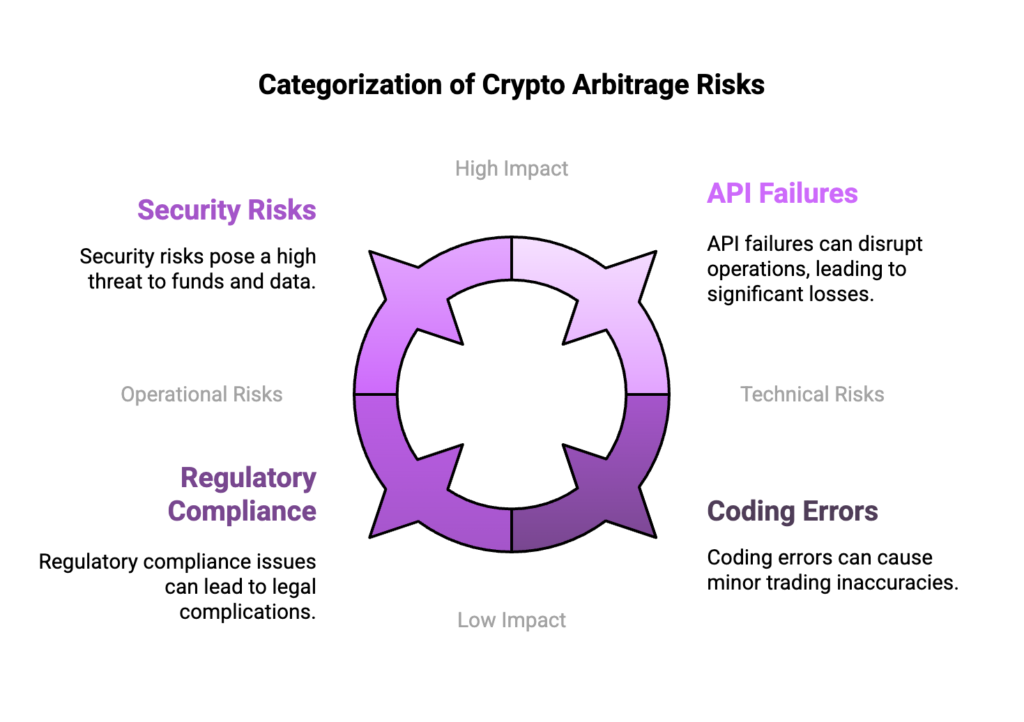Did you know that over $14 billion was lost to hacks in crypto in 2021? Crypto arbitrage bots offer an automated way to capitalize on price discrepancies across exchanges, but with great opportunity comes inherent risk. Effective risk management is crucial to protect investments, ensure profitability, and maintain the long-term viability of your trading bot. This article explores key risks associated with crypto arbitrage bots and outlines strategies to mitigate them.
1. Understanding Risks in Crypto Arbitrage
1.1 Market Risks
-
Volatility:
Cryptocurrency markets are highly volatile, with prices changing rapidly, potentially negating arbitrage opportunities. -
Liquidity Risk:
Insufficient market liquidity may prevent the bot from executing trades at the desired price or volume.
1.2 Technical Risks
-
Latency:
Delays in data retrieval, decision-making, or execution can lead to missed opportunities or losses. -
API Failures:
Dependency on exchange APIs means downtime or errors could disrupt bot operations. -
Coding Errors:
Flaws in the bot’s code can result in incorrect trades or unintended losses.
1.3 Operational Risks
- Fees and Costs: Trading fees, withdrawal fees, and network fees can erode profits.
- Regulatory Compliance: Operating in jurisdictions with unclear or restrictive regulations can lead to legal issues.
- Security Risks: Hacks, data breaches, or theft of API keys can compromise funds and sensitive information.

2. Essential Risk Management Strategies
2.1 Diversification
- Spread Across Exchanges:
- Distribute funds across multiple exchanges to reduce exposure to a single platform.
- Trade Multiple Assets:
- Avoid concentrating trades in one or two cryptocurrencies; diversify to mitigate asset-specific risks.
2.2 Implement Stop-Loss Mechanisms
- Automated Stop-Loss Orders:
- Program the bot to halt trading when losses exceed a predefined threshold, such as a 5% decline in total portfolio value.
- Threshold Setting:
- Set thresholds based on historical volatility and trading patterns of the assets being traded. For instance, a highly volatile asset might have a stop-loss at 10%, while a more stable asset could have a tighter threshold of 3%.
- Time-Based Limits:
- Cease operations during periods of extreme market volatility, such as after major economic announcements or sudden market crashes.
2.3 Monitor and Adjust Strategies
- Regular Performance Reviews:
- Analyze the bot’s trading history to identify patterns or issues.
- Strategy Adaptation:
- Modify strategies based on market conditions, such as switching from simple to triangular arbitrage during low volatility.
2.4 Use Reliable Data Sources
- Low-Latency APIs:
- Opt for high-speed APIs to minimize delays in data retrieval and trade execution.
- Data Validation:
- Cross-check data from multiple sources to ensure accuracy.
2.5 Leverage Cloud and Redundant Systems
- Cloud Hosting:
- Deploy the bot on a cloud platform for high availability and reduced latency.
- Redundant Systems:
- Use backup servers or bots to ensure continuity during outages.

3. Mitigating Security Risks
3.1 API Key Management
- Permission Restrictions:
- Use API keys with limited permissions (e.g., trading only, no withdrawals).
- Key Rotation:
- Regularly update API keys to minimize risks of unauthorized access.
3.2 Secure Communication
- Encryption:
- Encrypt communications between the bot and exchanges to prevent interception.
- Two-Factor Authentication (2FA):
- Enable 2FA on exchange accounts to add an extra layer of security.
3.3 Cybersecurity Best Practices
- Firewall Protection:
- Use firewalls to block unauthorized access to the bot.
- Regular Updates:
- Keep the bot’s software and dependencies updated to patch vulnerabilities.
- Audit and Penetration Testing:
- Regularly test the bot for potential security flaws.
4. Financial and Regulatory Risk Management
4.1 Fee Optimization
- Low-Fee Exchanges:
- Prioritize exchanges with lower trading and withdrawal fees.
- Batch Transactions:
- Combine smaller trades to reduce the overall fee impact.
4.2 Maintain Sufficient Capital
- Avoid Overleveraging:
- Use only funds you can afford to lose and maintain a reserve for emergencies.
- Minimum Balances:
- Ensure adequate funds in exchange wallets to avoid transaction failures.
4.3 Regulatory Compliance
- United States:
- Register with the Financial Crimes Enforcement Network (FinCEN) if operating as a Money Services Business (MSB).
- Adhere to Anti-Money Laundering (AML) and Know Your Customer (KYC) regulations.
- Pay capital gains tax on cryptocurrency earnings.
- European Union:
- Comply with the EU’s Markets in Crypto-Assets (MiCA) framework.
- Follow GDPR guidelines for data protection.
- Ensure AML/KYC compliance when dealing with EU-based exchanges.
- Asia:
- Japan requires registration with the Financial Services Agency (FSA).
- South Korea mandates compliance with strict KYC/AML requirements.
- Singapore offers a crypto-friendly environment but requires a license under the Payment Services Act.
5. Continuous Monitoring and Improvement
- Performance Metrics:
- Track key performance indicators (KPIs) like profit margins, success rates, and execution speeds.
- Real-Time Alerts:
- Implement alerts for critical events, such as API errors or unusual market conditions.
- Community Engagement:
- Participate in forums and communities to stay updated on best practices and emerging risks.
Conclusion
Risk management is the cornerstone of successful crypto arbitrage bot operations. By understanding potential risks and implementing robust mitigation strategies, traders can safeguard their investments and enhance profitability. A proactive approach, combined with continuous monitoring and adaptation, ensures that your bot remains resilient in the dynamic cryptocurrency market.
Ready to optimize your bot for risk management?
Explore advanced guides and tools to secure your trading future today!


